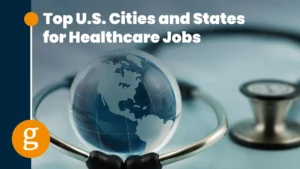Top U.S. Cities and States for Healthcare Jobs
Goodwin Recruiting | Career Advice, Healthcare, Industry News, Opportunity for All, Senior Living | October 29, 2025

The U.S. healthcare industry is evolving fast. Major transformations are taking place, from personalized, data-driven treatment to using artificial intelligence (AI) for predictive care and documentation, new hiring models and upskilling tools to incentivize and retain staff, and integrative, value-based care models that combine medical, behavioral, and social patient support.
Healthcare workers are contributing to industry change. Workforce shortages remain one of the biggest challenges in the U.S. healthcare market, and one big reason is that healthcare workers are also taking a more personalized approach – to their careers and lifestyles. Retirements are playing a huge role in talent shortages, but working professionals want better job opportunities and higher satisfaction.
Relocating is one way to achieve those goals. If you’re considering the possibility of moving, you know it’s a deeply personal choice. Narrowing down your geographic search depends on what you want for your life, career, and family. As you review the information in this article, keep in mind that the best destination for you should be more about you than the size or number of opportunities in a specific healthcare market.
What are the best cities and states for healthcare jobs?
What’s happening in the healthcare industry overall, including employment trends?
Read on for answers, insights, and ideas to inspire your journey!
Insights into the healthcare industry and job market
Whether you want to advance your area of expertise, pursue a different role or healthcare sector, or simply enter the field, the cost of living and quality of life may weigh heavily in your location choice. (U.S. News & World Report recently released its ranking for the top 25 cities offering the highest quality of life). Or you may want opportunities with employers offering the greatest demographic diversity in their workforce. These and other factors can play a big role in where you look for a new healthcare job.
Fortunately, you can take comfort in knowing that opportunities are plentiful from coast to coast. Here are two reasons:
- You’re a member of the largest U.S. workforce.
- Healthcare workers across all disciplines are in growing demand everywhere, and for the long term. Think job security!
One of the largest sectors of our national economy: The U.S. healthcare and social assistance industry currently generates about $4.3 trillion in annual revenue, representing a 4% annualized growth over the past five years, and it supports more than 22 million jobs nationwide. It includes providers, services, payers, technology, pharmaceuticals, insurance, and regulatory bodies that make up our massive healthcare ecosystem. Major sectors include hospital care, outpatient and ambulatory services, health insurance, digital health platforms, pharmacies, and pharmaceuticals.
The fastest-growing U.S. sector for years to come: The U.S. Bureau of Labor Statistics (BLS) projects the healthcare and social assistance sector to be the fastest-growing industry through 2034 (+8.4%), largely driven by an aging population. Healthcare support occupations and practitioners and associated technical occupations are projected to be among the fastest-growing occupational groups in the sector, growing 12.4% and 7.2%, respectively. These professionals include key members of care teams, such as nurse practitioners, physical therapist assistants, and physician assistants.
Job openings per year: About 1.9 million job openings are projected each year through 2034, on average, in healthcare occupations due to employment growth and the need to replace workers who leave their occupations. It’s interesting to note that there are nearly 50 different occupational groups within the healthcare sector. Beyond the commonly known groups, occupations range from athletic trainers to dental hygienists, dieticians, genetics counselors, nuclear medicine technologists, speech-language pathologists, veterinary technicians, and many more.
Healthcare occupations with the highest projected employment growth rates through 2034:
- Nurse practitioners: 40%
- Medical and health services managers: 23%
- Physical therapist assistants: 22%
- Physician assistants: 20%
- Psychiatric technicians: 20%
- Ophthalmic medical technicians: 20%
- Occupational therapy assistants: 19%
- Hearing aid specialists: 18%
- Health specialties teachers, postsecondary: 17%
- Home health and personal care aides: 17%
- Nursing instructors and teachers, postsecondary: 17%
- Substance abuse, behavioral disorder, and mental health counselors: 17%
- It’s important to note that the healthcare IT market is also growing fast. With 80% of hospitals relying on electronic health records, and with AI increasingly used in diagnostics, surgery assistance, data analytics, workflow automation, personalized medicine, and data security, the global healthcare IT market is anticipating nearly 16% growth through 2030. Here are seven important IT Jobs in healthcare.
Employers are focused on changes for healthier workers and patients
The American Hospital Association (AHA) 2025 Healthcare Workforce Scan reveals four factors shaping today’s healthcare workforce, citing how traditional models may no longer suffice in the face of challenges like staff burnout and turnover, and the need for a more agile, resilient, engaged, and tech-confident workforce.
- Embracing technologically integrated care models and innovations: Healthcare leaders are turning to AI and virtual care models to address issues like provider burnout and financial pressures by improving operational efficiency while relieving some of the burdens on front-line team members.
- Engaging clinicians in tech strategies: The adoption of AI and other technologies requires engaging clinicians in the process. Leaders are focusing on continuous training that emphasizes the use of new technologies and their value in enhancing patient care and streamlining tasks.
- Boosting access through partnerships, training, and upskilling: In response to the healthcare field’s significant workforce shortages, particularly in primary, maternal, long-term, behavioral health, and rural care, hospital leaders are partnering with educational institutions and community organizations to create new pathways into healthcare careers.
- Rethinking engagement to build a more flexible, engaged workforce: While meaning and purpose at work are valuable, employee retention also requires trust, support, belonging, recognition, and adequate resources. Organizations are focusing on building inclusive cultures where all team members feel valued, supported, and well-represented.
What states currently offer the best healthcare?
This list may be intriguing to you in considering where you want to live and work. Aptly stated by U.S. News & World Report, few factors bear as heavily on the well-being of any state’s citizens as their overall health. In evaluating the best states for healthcare, the publication examined metrics reflecting healthcare access, healthcare quality, and public health outcomes. These are the results:
- Hawaii
- Massachusetts
- Connecticut
- Rhode Island
- New Jersey
- Maryland
- California
- New York
- Colorado
- Delaware
Top U.S. cities for healthcare jobs
Although far from a comprehensive list of top U.S. cities for healthcare jobs, the following cities certainly stand out in providing numerous job opportunities, competitive wages, and significant opportunities for cutting edge career advancement.
In rank order…
- Houston, Texas, is home to the renowned nonprofit Texas Medical Center, with the world’s largest group of research and healthcare institutions comprised of 49 healthcare member organizations. It also has one of the largest healthcare workforces in the United States, employing 73,600 people.
- Philadelphia, Pennsylvania, is one of the largest cities defined as a hub for biomedical and pharmaceutical firms. Home to the Academy and College of Philadelphia, the city’s extensive medical system also features the University of Pennsylvania’s largest teaching hospital with affiliations based in the Temple University School of Medicine, Drexel University College of Medicine, Thomas Jefferson University, and the Philadelphia College of Osteopathic Medicine.
- Baltimore, Maryland, in its proximity to Washington, D.C., is known for offering healthcare professionals numerous employment opportunities within public and governmental organizations.
- Boston, Massachusetts, is a hub for healthcare and medical research, with institutions like Massachusetts General Hospital offering ample job opportunities. The Cambridge-Quincy area is a thriving healthcare industry due to National Institutes of Health (NIH) federally funded programs.
- Milwaukee, Wisconsin, is one of the best cities for healthcare jobs due to the number of expanding healthcare systems in its economy, including public, private, and nonprofit healthcare businesses affiliated with local and federal organizations. The Milwaukee Regional Medical Complex, Aurora Health Care, and ThedaCare are just a few of many facilities offering health practitioners, social workers, and other professionals thriving career opportunities.
- Denver, Colorado, offers healthcare professionals secure and sustainable employment through its Health Care and Social Assistance program, which has added thousands of jobs yearly since its inception in 1990. Denver is home to some of the nation’s top healthcare employers, such as the Medical Center of Aurora, Quest Diagnostics, Vitalant Blood Donation Center, Children’s Hospital Colorado, and the Columbine Physicians Group.
- Fargo, North Dakota, is home to influential healthcare organizations, including Blue Cross Blue Shield of North Dakota (BCBSND), as well as Noridian Solutions, a leader in developing operational solutions for federal, state, and health plan programs nationwide. SMP Health and Ethos Home Health Care and Hospice are also based in Fargo, one of the best U.S. cities to live and work due to its thriving job market in sectors like healthcare, technology, and manufacturing, combined with an affordable cost of living.
- New York, New York, has received substantial funding from the NIH to focus on expanding medical care and research since 2009. The city has experienced rapid, far-reaching growth in public and private healthcare sectors, medical research, and medical technologies.
- Cleveland, Ohio, offers numerous opportunities in the healthcare sector, supported by renowned medical institutions like the Cleveland Clinic, which is one of the United States’ best hospitals and one of the city’s largest private employers. There are job opportunities within its University Hospitals of Cleveland and MetroHealth medical centers.
- Norfolk, Virginia, is one of the most prominent U.S. locations offering internationally renowned research, education, and specialized roles in healthcare. The Eastern Virginia Medical School, Portsmouth Naval Hospital, Sentara Norfolk General Hospital, Bon Secours DePaul Medical Center, V.A. Hospital, and the Children’s Hospital of The King’s Daughters provide healthcare professionals sustainable employment, training, research, and continuing education opportunities based on grants from the NIH and other federal programs.
Top U.S. states for healthcare jobs
These 10 states have some of the highest demand for healthcare workers, providing abundant job opportunities for professionals to increase your skills, expertise, and income.
In alphabetical order…
- California is the state with the highest population in the country – and it also has the highest demand for healthcare workers, from nurses to physicians, pharmacists, and allied healthcare professionals, such as medical assistants, imaging specialists and more.
- Florida is a popular retirement destination, and the general population is expected to grow by nearly 300,000 new residents a year, so naturally, this is one of the states with the highest demand for healthcare workers.
- Georgia’s healthcare sector is currently seeing unprecedented growth, specifically across Central Georgia. As the state’s over-65 population grows, the healthcare industry will face increased challenges, including a shortage of healthcare professionals and higher needs in levels of patient care. This will disproportionately impact rural and smaller metropolitan communities that already face acute challenges as their patient base is smaller than that of larger metropolitan areas.
- Illinois, with its rural areas, is projected to have a shortage of over 6,200 doctors by 2030, and is also experiencing severe shortages of nursing and allied healthcare professionals, leaving the door wide open for employment in a state where one in 10 jobs is in healthcare. Illinois hospitals and health systems infuse nearly $118 billion into the state’s economy, and more than 15,000 life sciences firms also call Illinois home.
- New York needs healthcare professionals from primary care physicians to nurse practitioners, psychiatrists, and more. To help increase providers in the state, New York plans to add 1,640 nurse practitioner roles annually.
- North Carolina has enacted policies to recruit more healthcare workers. The National Health Service Corps is providing student loan repayments for healthcare workers in the state and increasing funding to all counties with a healthcare shortage. Efforts to recruit healthcare workers and provide student loan repayments make North Carolina a top choice.
- Ohio is a great state for healthcare jobs with a strong job market, high demand for healthcare professionals, revered medical institutions, and a lower cost of living. As mentioned, the state is home to world-class facilities like the Cleveland Clinic, as well as the Ohio State University Wexner Medical Center in Columbus, with positive job outlooks and potential for high job satisfaction.
- Pennsylvania has twice as many medically underserved areas as the average state, but it is also a leading state for training new healthcare industry professionals.
- Texas is experiencing fast population growth and needs more physicians and healthcare workers in general. With well-documented shortages of primary care physicians and other specialists, growing the healthcare workforce in the state is a top priority, including the number of behavioral health professionals.
- Wisconsin continues to demonstrate a strong commitment to delivering high-quality care and reinforcing its reputation for excellence in healthcare by improving patient outcomes, safety, and community health, from rural hospitals to urban medical centers. The state, like the rest of the nation, continues to experience a sustained nursing and allied professional shortage and is actively working to fill these gaps.
Work with a leading healthcare recruiter to plot your move
Whether you’re a recent graduate or an experienced healthcare professional, moving somewhere new is worth considering in finding greater satisfaction in your career. There’s a growing need for your skills and experience in cities and states across the nation, regardless of your current healthcare profession or your anticipated shift to a different area of this vast and growing industry.
So, if you’re thinking about the most promising locations to explore the healthcare job scene, we can help. Goodwin Recruiting is a leading nationwide talent recruiting firm and healthcare recruiting is one of our areas of specialization. We would be honored to work with you in finding the right job opportunity in a city or state that aligns with your career and life goals.
Connect today with one of our expert healthcare recruiters, or explore our job board for healthcare jobs nationwide that are available with leading employers through Goodwin Recruiting. And be sure to sign up for our job alerts, as new positions are added every day.
Share This Article














































